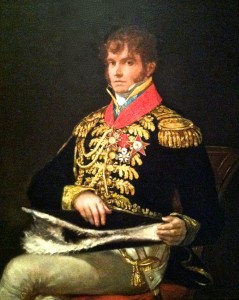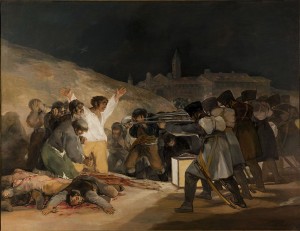 Last weekend at the Virginia Museum of Fine Arts in Richmond, I came across Francisco Goya’s stunning painting of the Napoleonic general Nicolas Philippe Guye. Guye had been wounded at Austerlitz and later served as aide-de-camp to Napoleon’s older brother Joseph. In 1810, when Goya painted this portrait, Guye was governor of Seville and Joseph Bonaparte King of Spain.
Last weekend at the Virginia Museum of Fine Arts in Richmond, I came across Francisco Goya’s stunning painting of the Napoleonic general Nicolas Philippe Guye. Guye had been wounded at Austerlitz and later served as aide-de-camp to Napoleon’s older brother Joseph. In 1810, when Goya painted this portrait, Guye was governor of Seville and Joseph Bonaparte King of Spain.
Goya’s sympathetic portrait of a French general surprised me. I’d always thought of him as the Spanish patriot who gruesomely portrayed French invaders executing Spaniards in his famous painting The Third of May 1808. Like many tales of the brutal Spanish Peninsula War (1807-1814), there are two sides to Goya’s story.
Before the French invasion, Goya had worked his way up to Spanish court artist, painting a number of royal portraits. He was, however, against the Inquisition, which operated with unbridled power, torturing, imprisoning, and killing innocent citizens. When Spanish King Carlos IV and his son Ferdinand VII abdicated under pressure from Napoleon, Goya welcomed the French who abolished the Inquisition. Having sworn loyalty to King Joseph (Bonaparte), he enjoyed great popularity among the French and Spanish ruling class. 
The Spanish people, however, rebelled against French rule. In the ensuing conflict, both sides committed atrocities. Goya became disillusioned with Joseph’s rule (as did Napoleon himself). In 1814, when the tide changed and Ferdinand VII reclaimed the throne, Goya painted The Third of May 1808 and a series called The Disasters of War.
Scholars disagree whether Goya was an opportunist, a French sympathizer or a Spanish patriot. Few, however, doubt his talent as a painter.

I love reading your blog! I always learn something and I enjoy your perspective. Impressive!
Hi Margaret, Thanks for your comments. Tanks for your link, very good!! We ‘ll write a new article. i’m very interested;
When ever I pass that way en route to or from New Jersey, I like to go take a look at Joseph Bonaparte’s home in Bordentown (albeit overpowered by a cranberry processing plant in the immediate vicinity). It is of course a Directoire house now entirely boarded up and standing on excessively wet ground,a plaisance that I attempted to navigate in delicate shoes in order to investigate the roses that were in bloom and placed somewhat for the privacy of intimate conversation as had been the style of that era. Across the way are the caretakers, brothers of the order of St.Joseph, where I looked in at the entranceway but noticed nobody about. There is still a well known group of realtors about town by the name of Bonaparte.
Hello, Dianne,
I’m so glad you brought up Joseph’s home in Bordentown. I had read that it had been destroyed years ago, obviously wrong information. I will check it out and follow up on the realtors named Bonaparte, too.
Margaret
I note your comments concerning Goya. My Swiss partners mother was a Guye, from the same area in the Jura mountains that general baron Guye came from. I have written to various archive sources in the French Jura and, although they cannot confirm the fact 100%, they still consider that my partners mother, and her family, were in all probability related to the general.Although the general himself was without issue, his brother had children, one of whom was also painted by Goya.
Sincerely,
Graham J.Morris MA BA(Hons)
Interesting! The man in this painting is quite a handsome, dashing fellow.
Thanks for your comment.
The answer for the enigma is easy: He had to survive. He wasn’t a héroe, like the patriots in Cádiz, the only one city that resisted all the Spanish Independence War. At the time of truth, many decide to survive, not to fight, that’s human reality.
Yes, and it’s perhaps best for us not to pass judgment since we don’t know what we ourselves would do faced with the same choice.
Pingback: Francisco de Goya y Lucientes, Disasters of War and the Napoleonic Empire during the Peninsular War [video] - The Circular